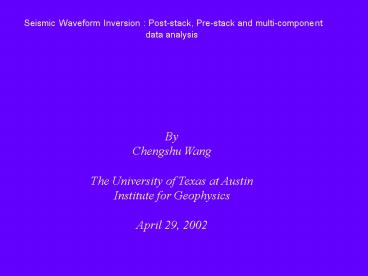Seismic Waveform Inversion : Poststack, Prestack and multicomponent data analysis - PowerPoint PPT Presentation
1 / 29
Title:
Seismic Waveform Inversion : Poststack, Prestack and multicomponent data analysis
Description:
Seismic Waveform Inversion : Poststack, Prestack and multicomponent data analysis – PowerPoint PPT presentation
Number of Views:2196
Avg rating:3.0/5.0
Title: Seismic Waveform Inversion : Poststack, Prestack and multicomponent data analysis
1
Seismic Waveform Inversion Post-stack,
Pre-stack and multi-component data analysis
By Chengshu Wang The University of Texas
at Austin Institute for Geophysics April 29, 2002
2
Dissertation Plan
- Chapter I Introduction
- Chapter II Velocity Estimation from post-stack
seismic data and density log by a linearized
Inversion - Chapter III Analysis of multi-component data
offshore Oregon estimation of elastic
properties of gas hydrates - Chapter IV Pre-stack inversion of offshore
Oregon streamer data - Summary
3
Status
- Chapter I
- Chapter II Work completed an abstract has been
submitted to SEG Geophysics paper near
completion - Chapter III Velocity analysis done
interpretation in progress - Chapter IV Data processing started
- Summary
4
Overview of my Research
5
- Nonlinear inversion theory and conjugate gradient
algorithm - Definition of Cost Function
- S(m) (1/2)(?dTCD-1?d ?mTCM-1?m),
- Data Covariance matricex CD
- Model Covariance Matrix CM.
- Preconditioned Conjugate Gradient Algorithm
- Minimization of the cost function for nonlinear
function f(m) may be achieved by using the
preconditioned conjugate gradient algorithm.
6
- Nonlinear inversion theory and conjugate gradient
algorithm - How to determine matrices CD and CM ?
- A priori conditions for determination of CD and
CM - We assume that the observed data are
uncorrelated (NOT NECESSARY) - The diagonal matrix is chosen as the forms of
both CD and CM
7
- Two experiments have been done
- Joint nonlinear inversion of the reflected P-wave
and S-wave amplitudes - Nonlinear waveform inversion of post-stack data
(Real P-wave data)
8
Nonlinear PP and PS AVO inversion Synthetic Tests
9
(No Transcript)
10
Velocity Estimation from Post-stack data and
density log Examples from Costa-Rica
ExperimentWang, C., M. K. Sen, and K. McIntosh,
2002, SEG expanded abstract, Submitted.
11
Algorithm
- Density log available
- Wavelet estimated
- Low frequency velocity known
- Estimate model and data variances
- Estimate of fractional changes in velocity by a
non-linear conjugate gradient algorithm
12
Fig.3. Port of post-stack time-migrated section
of MCS Line 20 showing trench and lower slope off
the Nicoya Penisula, Costa Rica. Three seaward
drill sites of Leg 170 transect are marked. Site
1039 is the reference site on Cosos Plate while
sites 1043 and 1040 cross the toe of the upper
plate and the underthrust sedimentary section.
All three holes penetrated to the basement of the
Cocos Plate, here consisting of Gabbro sills.
13
Estimation of Data and Model Variances A New
Approach
14
Fig. 6 Model smoothing and final inversion
results for Site 1039. (1) Smoothing model
(velocities) using original starting velocities
at the first step of the whole inversion process.
The second step of the process, using smoothed
model as new starting model and the best pair of
?d and ?m generating matrices CD and CM produces
two results (2) final model (velocities) being
the best of estimates of model, and (3) best data
fitting.
15
Fig. 8. Interpolation of velocity estimates and
corresponding data fitting between sites 1043 and
1039 with geological interpretation. (a) The
estimates of velocities by interpolation and
density profiles with marks of major
stratigraphic surfaces. (b) the seismic data
fitting on seismic section consisting of 13
picked CDPs, showing marks of prominent
reflectors. See the text in detail.
16
Offshore Oregon Seismic Experiment Vp/Vs
analysis of hydrated sediments
17
Field Geometry Location
18
Hydrate Ridge Experiment
- 3D Survey comprised 81 profiles spaced 50m apart
- Shots from 2 GI guns recorded simultaneously
- 600-m-long 48 channel streamer
- An array of 21 4-component ocean bottom
seismometers
19
Hydrate Ridge Experiment
- 4X9 km2 region on hydrate ridge on the Oregon
Continental margin - Northern crest was drilled during ODP leg 146
- Evidence for hydrate and free gas were found
- Multi-channel data from 1989 show that a BSR is
ubiquitous beneath this ridge.
20
Processing of OBS Data
- Rotation, filtering, and Decon
- Correlation between multi-channel and OBS data
- Plane wave transformation
- Interactive PP, PS, PSS .. Velocity analysis
- Amplitude analysis
21
OBS Data superimposed on multi-channel line
22
OBS 101NS Tau-P
23
Ray path and PS conversion
24
OBS 101ns (hydrophone) tau-p and NMO-correction
25
OBS 101NS (radial) tau-p with NMO correction
26
Velocity profiles of Line EW1
27
Results from Velocity Analysis of Oregon Data
- Discovery of a low-velocity zone beneath the
seafloor indicative of the presence of free gas - identification of a high velocity hydrate layer
- new interpretation in progress
28
Acoustic Bubble Plume
29
ACKNOWLEDGEMENTS
I have been supported by grants from the
National Sciences Foundation (NSF) and the
Department of Energy (PI . Dr. Mrinal Sen).

